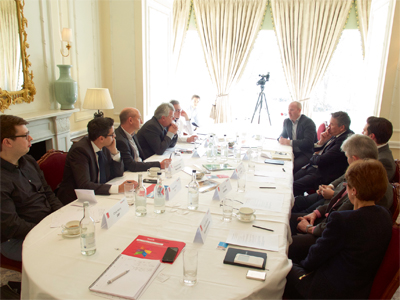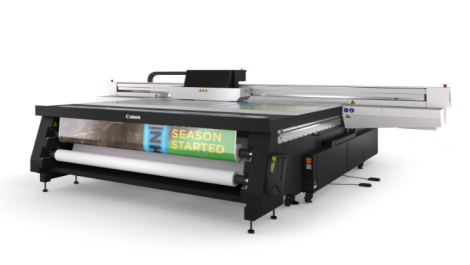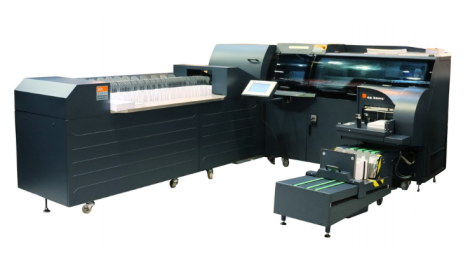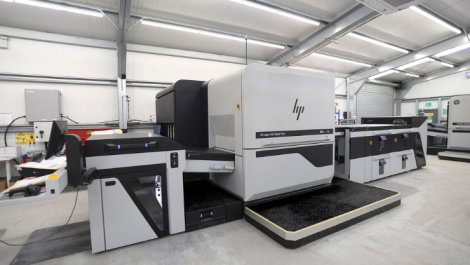The participants talking about printing and drupa
drupa ‘the print Olympics’ gets underway in Düsseldorf in June. Digital Printer’s panel of elite printers and suppliers came together in advance to discuss how they were getting competition-ready.
At the end of June, Britain votes to decide whether to stay in or to leave the European Union, shaping its long-term future and standing in the world. For printers there is another European event that could have a seismic impact on their future prosperity. It is, of course, drupa – the mother of all print shows. At the end of February Digital Printer brought together a select group of printers and vendors at the Savoy hotel on London’s strand to discuss the state of the industry, the challenges faced and how a trip into the heart of Europe at the beginning of that momentous month could be used by printers to secure a prosperous future for their businesses.
Around the table
Alison Branch, managing director, Park Communications
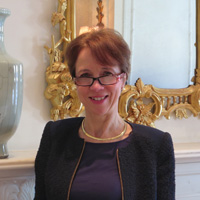
Number of drupas: It would be rude to ask a lady
Park is a London-based firm that in the words of Ms Branch provides ‘beautiful print and fantastic customer service’. It serves the financial, fine art and magazine markets. It added digital to its B1 litho last year with an HP Indigo 7800.
Jim Todd, sales director, Heidelberg UK
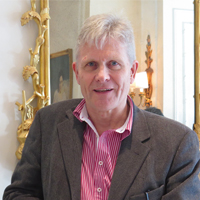
Number of drupas: 9
Heidelberg is the largest litho press manufacturer and also offers workflow, consumables and service. It has cut sheet toner digital presses based on Ricoh technology and recently announced the Primefire 106, a B1 inkjet machine co-developed with Fujifilm. Skipping 3D printing, it has also launched the Omnifire – a machine for printing onto objects, which it terms 4D printing.
Paul Manning, managing director, Rapidity
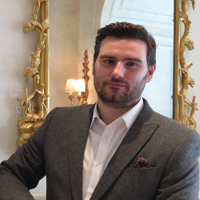
Number of drupas: 4
Central London based digital printer. ‘Our differentiators are we’re local and we’re automated,’ says Mr Manning. An all-digital business mixing small and, as of last year, large-format.
Mike Holyoake, general manager UK & Netherlands, Xerox Graphics
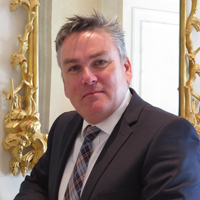
Number of drupas: 6
Xerox is a stalwart of the digital printing industry with iconic products including the DocuTech, DocuColor and iGen as examples of its category-defining devices. This drupa will be its first outing with a significant inkjet presence, following its acquisition of French firm Impika.
Anthony Thirlby, chief operating officer, Pureprint.

Number of drupas: 4
Pureprint’s speciality is ‘anything you can print’, which it does across three production sites specialising in litho, digital and large format. Its production firepower is kept filled by seven sales offices.
Giles Bowes, managing director, Concept Communications Group
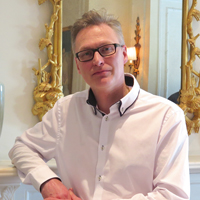
Number of drupas: 3
An all-digital house based in Essex, Concept Communication’s focus is on capturing high value pages and delivering them using smart automated workflows and a pair of HP Indigos. It is part of ProCo, the Sheffield-headquartered marketing services firm.
Mike Horsten, marketing director, Mimaki Europe
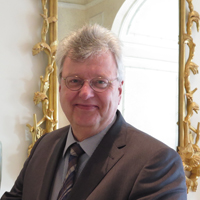
Number of drupas: 9
Mimaki manufactures inkjet printers, cutter/printers and cutting tables. While many of its products are wide-format, it also offers compact devices for printing direct to object and now 3D print.
Adrian Steele, managing director, Mercian Labels
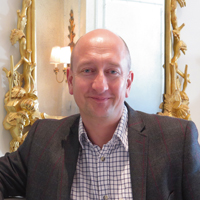
Number of drupas: 3
Mercian Labels is a label producer that uses flexo and digital technologies to meet client needs; it is also using the potential offered by digital technology to diversify into new packaging markets such as digital cartons.
Ronen Zioni, marketing director, HP graphic solutions EMEA.
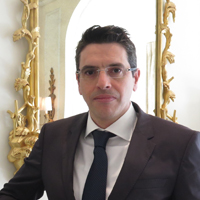
Number of drupas: 4
With its Indigo, PageWide, DesignJet and Scitex brands, HP is a formidable player in digital, with offerings in cut sheet, continuous feed and wide format production.
Chris Henry, marketing manager, SMP
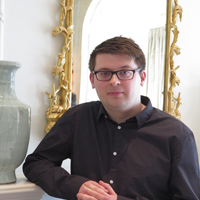
Number of drupas: 0
South London-based SMP is one of the largest point-of-sale printers in the UK and is also involved in out of home and increasingly experiential and event work. It uses a combination of large format litho and digital, including the world’s first Inca Onset X3. Mr Henry has a background in social, digital and experiential marketing.
Innovation & efficiency
Mike Holyoake (Xerox): I think it is becoming clearer that there are two reasons people go to drupa: they are looking for efficiency and/or innovation. Automation is a tool for improving efficiency; it is a protection strategy – a way of putting an arm around clients and making it easy for them to do business with you.
Adrian Steele (Mercian Labels): Our aim is total automation, from unloading materials all the way through to despatch. It’s done in the automotive sector. The question is what is the cost? The challenge is, if it’s too expensive to totally automate, then you have no budget left to innovate.
Anthony Thirlby (Pureprint Group): We follow the 80:20 rule: 80% of our business is volume; 20% is value and innovation. You can’t run a business just on the 20%.
Automation & integration
Adrian Steele: In the next five years, wage costs are going to rise thanks to the minimum wage, increased pensions contribution costs and rises in the cost of living. At the same time, customers are demanding faster turnaround. The answer to both of those challenges is more automation, and not just in manufacturing. We will automate back office tasks and the way that we integrate with our customers. They are SMEs. They don’t want print industry-specific tools and we have to make it easy to order products from us.
Alison Branch (Park Communications): There are three drivers for automation: customers’ margin pressure; their demand for quicker time to market; and fewer staff doing more in their marketing departments – their time is increasingly precious. We’re looking at automation in customer service.
Mike Horsten (Mimaki): An example is Metro Group: it’s a huge company but the marketing department is three people. They aren’t so worried about cost, they just need support; that is a huge change.
Jim Todd (Heidelberg UK): More automation means you can spend more time with the customer. As the head butler said, it’s the personal touch that matters. You want high value time with the customer and you want high value pages from them.
Adrian Steele: People buy from people. Automation means that you can spend quality time with your customers, solving their business problems.
Paul Manning (Rapidity): Unfortunately, although we want it to be more open and easier to integrate it seems to be that the trend from the suppliers is to go the other way.
Adrian Steele: As a print provider our biggest frustration is the problem with open-architecture – or not – of vendors’ products. How open is open? We chose to develop a system because of that and have two people who do nothing but code.
Anthony Thirlby: My top objective is finding out how a vendor will work with us. I’ve yet to meet any vendor who really understands our workflow from enquiry received to product delivered.
Ronen Zioni (HP): I’ll be very interested to see how the industry reacts to HP PrintOS.
From show & sell to share & listen
Paul Manning: The last show was frustrating. We were chasing presses that weren’t real around the halls.
Ronen Zioni: Addressing your point, every vendor that respects themselves will bring products to show that are either ready or at least have a shipping date.
Giles Bowes (Concept Communications Group): It’s important to see the concepts, as it shows the direction of the industry.
Adrian Steele: I can see a change in attitude from ‘ta da! Here’s a new machine’, to one where more firms are engaging in a dialogue with printers. ‘Here, have a look at this as an idea, what do you think?’ For example, Xeikon with the Trillium, and Xaar with some of its printhead technology. The lifespan of the technology is getting shorter and the cost is getting higher and higher. In the labels market, presses have risen from £500,000 to £1.5 million. You may not buy at drupa but it will show you the direction of the market.
Ronen Zioni: It’s not just about printers and vendors, it’s about buyers too. We had Unilever at our centre in Barcelona recently to talk about innovation. Print buyers need to be confident that printers are capable of delivering – seeing the solutions to do that is a way of showing conviction to the buyer.
Anthony Thirlby: The problem in the UK is that those big clients are under print management, so printers can’t get a direct relationship with them. The UK is the most advanced print economy in the world – and I say that having had experience globally.
Added dimensions
Anthony Thirlby: I’m going to have a look at the new areas such as functional printing, 3D printing and packaging, but to date my problem with all these promised new opportunities is the lack of data on the return on investment. Our market and technology evaluation is on-going but there is a lack of data about how much of an opportunity there really is.
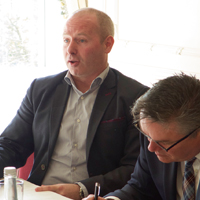
Anthony Thirlby, COO Pureprint
Adrian Steele: 3D printing is not for us. Functional printing – yes. Additional packaging products – yes; in particular digital cartons. Drupa is the only show where you can see all of this; especially the converting.
Ronen Zioni: In 3D, the biggest opportunity is in prototyping and engineering. We see some of our PSP customers get excited but it’s not where we think there is an opportunity for them.
Mike Horsten: We will show colour 3D printing.
Mike Holyoake: We will demonstrate printed electronics – we have some interesting technology in that space. I think it will become an important opportunity within the next five years.
Giles Bowes: It makes sense that we keep up to date with printed electronics.
Alison Branch: We’re interested in printed electronics. We’re also interested in 3D printing. One of our markets is high-end property and we think that there may be some opportunities for us.
Paul Manning: I’ve looked at 3D printing. It’s really cool technology but it’s hard for us to justify getting involved. Of our customers for who it would be relevant, the cost of getting into the market is so low that they have already done it themselves.
Anthony Thirlby: For us, the huge opportunity is packaging. The major packaging producers are focused on long run, high volume work. That means we see huge potential for any packaging needed in volumes of fewer than 50,000.
Right time, right place
Alison Branch: I’m time pressured, so to see everything under one roof in a few days is very valuable, even if I’m catching up on some developments that are a couple of years old. My biggest challenge at the show is managing my time. I need to plan and make appointments. At the moment I don’t know enough about what is going to be shown to do that. We need to plan how long to attend the show and which members of the team to take; for example, does it make most sense for the press guys or the finishing guys?
Chris Henry (SMP): Research ahead of the event is ultimately key, and for us, knowing what we want to see and finding out where we can see it, will make for a more productive visit.
Adrian Steele: It’s valuable to go and see all the headline technologies. Drupa in particular is valuable to look at things that are outside your core area. You can see the convergence – you don’t see that at a sector specific show like Label Expo or at vendor demonstrations. You do see it at generalist shows like drupa.
Do sweat the small stuff
Paul Manning: We spend less time at the big ticket vendors like HP, Xerox and more looking for smaller vendors and lower ticket bits of equipment that we wouldn’t otherwise be aware of. There are lots of innovative things out there from small companies with relatively low price tags of £20,000. Finishing is interesting; it can add a lot of value. There are gaps in the market for lower volume equipment – things such as case binding.
Mike Horsten: We look at drupa as an experience centre. What we offer compared to most vendors is totally different technology that can add value through differentiation. Like Paul said, our products are smaller and less expensive.
Alison Branch: Absolutely, the show is about the smaller stuff.
Ronen Zioni: Maybe come, but consciously don’t look at any kit; look for applications and business models.
Adrian Steele: It’s easy for us: because we’re focused on labels, 99% of the stuff is irrelevant to us. But the hardest thing is making time to go and look for the unknown things that could make a big difference.
Mike Holyoake: The big challenge for vendors is that we may not be at the top of people’s to-see list. How can we tap into people’s to-do list at the show; especially if people don’t associate us with a particular sector or solution?
Inspiration & education
Alison Branch: I am going because I want thought leadership and I want inspiration. There is a half-day workshop on creative publishing that I will attend. The topics include multi-sensory content. That sounds absolutely fascinating and it is exactly what will be of interest to my customer. That workshop gives something to go back and talk to customers about; we can add value and partner them. Quite often customers come to us and say ‘I’ve heard about such and such, can you find out about it and tell me more?’.
Paul Manning: I don’t see drupa as an event for networking. I’m not planning on going to any seminars; that is half a day that I’m not looking at equipment.
Anthony Thirlby: There is value in going to the seminars, even if it is just to sanity check what you’re already doing. It is a way to substantiate what you’re doing – often it can add some facts to your emotional feel. There is this shift in floor plan. Look at the space HP is taking for instance: printers go there for inspiration. Having said that, there is a misconception about the market shares of different production platforms that the show’s predominance of digital reinforces.
Chris Henry: The thought leadership side of drupa is interesting. The content drawn from it can help spark interesting conversations with clients and they no doubt want to continue to move forward with new ideas. Sharing that knowledge with them will be appreciated by them.
The idea of multi-sensory content that was touched upon by Alison could well be of interest with us, working with retailers and the way retail experiences are changing each day.
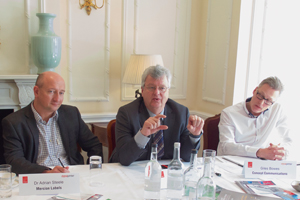
Horsten: Interested to see hybrid products
Adrian Steele: I hadn’t planned to attend a seminar – I’m going to have a look at them now.
Jim Todd: If they are not already, those seminars should be recorded and put on the web for people who couldn’t attend.
Can you afford not to go?
Jim Todd: We have customers who tell us that they aren’t going. I’d argue that’s being complacent and is dangerous. I want to see customers who don’t necessarily know what they want but who have come to explore without any pre-conceived ideas.
Adrian Steele: If you are going, leave enough time. I made the mistake when I went the first time of thinking I could do it in a day.
What are you going to see?
Alison Branch: Larger size digital. Finishing, because it’s still extremely labour-intensive. Automation in general.
Paul Manning: B2 and B1 digital, in particular inkjet as I can’t see how it stacks up.
Anthony Thirlby: We’ve got a three-year purchasing strategy; I’ll be checking that our vendors are on track. I will be looking for tools that can improve customer service to our very high-end customers.
Giles Bowes: I’m not going to buy anything specific. It is an opportunity to take clients and show them what is available. I am also interested in printed electronics.
Adrian Steele: I want to see where inkjet is and if the quality is adequate to replace toner; it has not been for labels yet.
Chris Henry: After today, we will discuss if it is a good idea to take some clients. Otherwise we’re going to look at digital ink technology.
Jim Todd: I’d like to see the maths on inkjet; and I will be there for new offset, of course.
Mike Holyoake: Inkjet and how far it has come. I want to understand the economics, where it is relevant and what the applications are. B2 digital is a conundrum. We spoke a lot today about automation but printing on bigger sheets is opposed to that as it puts more steps into the process.
Mike Horsten: I’m interested to see how digital can be integrated with analogue.
Ronen Zioni: As someone who has been preaching about the analogue to digital conversion for 15 years, I want to see where analogue is and what the next step is. Like everyone else I want to see the developments in inkjet.
About The Savoy
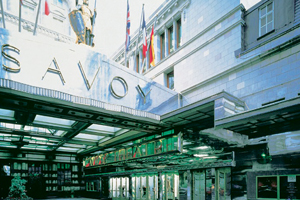
As a service-driven business and technology pioneer that has managed to retain its core values and heritage while re-inventing itself for the modern age The Savoy Hotel, located on London’s Strand and facing the River Thames, was a perfect venue for the roundtable.
The participants were treated to a brief talk about the hotel’s ethos and history by head butler Sean Davoren, who outlined details of the venue’s use of cutting edge technology when it first opened in 1889. It was the first hotel in London to have hot and cold running water, electricity and lifts – or as they were first called, ascending rooms – which, although it took a stately half an hour to reach the top of the building, still caused passengers to faint.
‘We believe in service,’ said Mr Davoren. ‘Our guests expect and demand high quality service. Service is everything, and as society has become more automated, our business has become more personalised, which is our strength.’
Mr Davoren also explained that it was the hotel of choice for the cognoscenti during the ‘season’, which stretched from Derby Day to Wimbledon, and which has parallels with print’s own season – drupa – 11 days in early June. Unfortunately, there is no outpost of The Savoy in Düsseldorf to use as a bolthole during the show.
